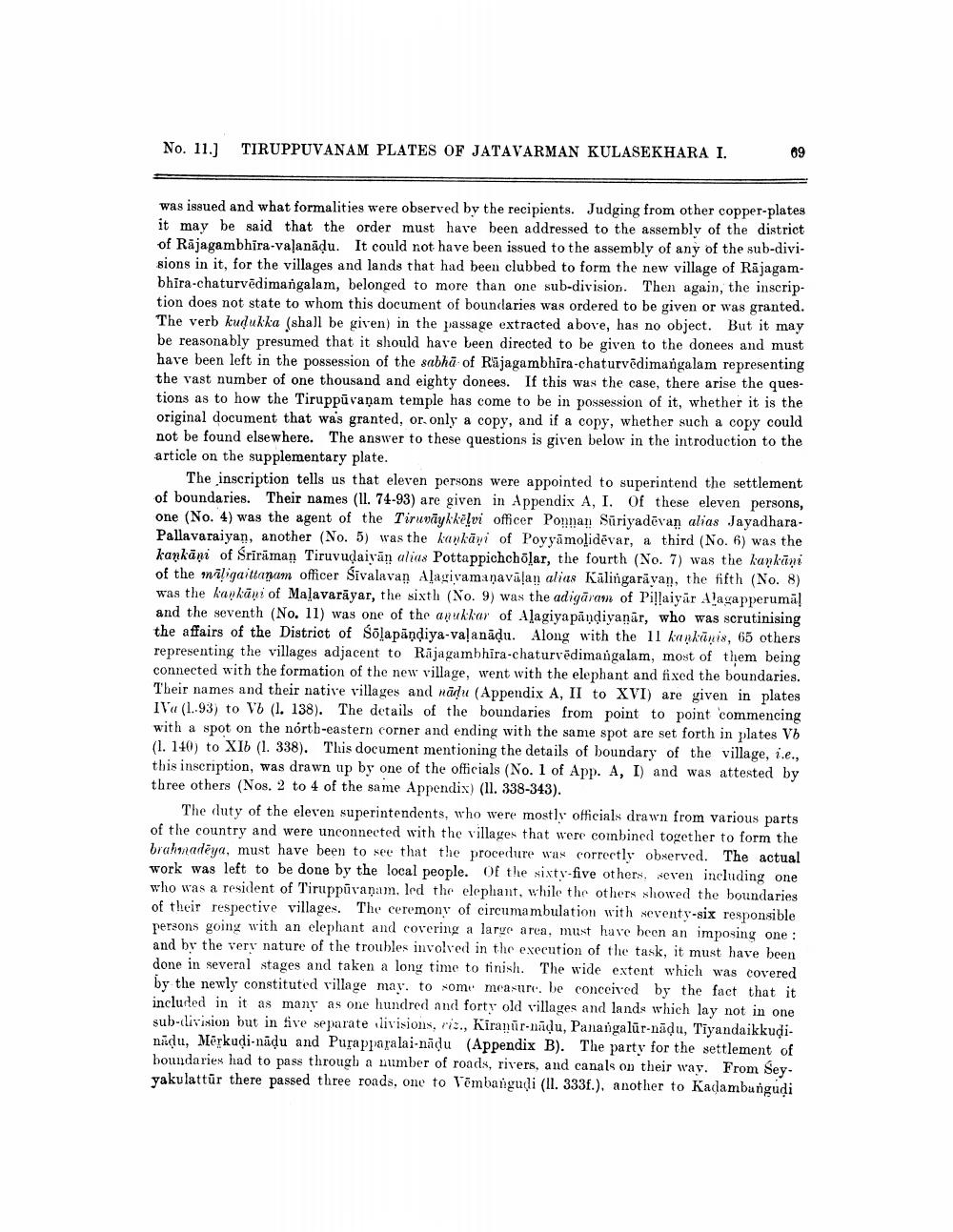________________
No. 11.)
TIRUPPUVANAM PLATES OF JATAVARMAN KULASEKHARA I.
was issued and what formalities were observed by the recipients. Judging from other copper-plates it may be said that the order must have been addressed to the assembly of the district of Rājagambhira-valanādu. It could not have been issued to the assembly of any of the sub-divisions in it, for the villages and lands that had been clubbed to form the new village of Rājagambhira-chaturvēdimangalam, belonged to more than one sub-division. Then again, the inscription does not state to whom this document of boundaries was ordered to be given or was granted. The verb kudukka (shall be given in the passage extracted above, has no object. But it may be reasonably presumed that it should have been directed to be given to the donees and must have been left in the possession of the sabhā of Rājagambhira-chaturvēdimangalam representing the vast number of one thousand and eighty donees. If this was the case, there arise the questions as to how the Tiruppūvanam temple has come to be in possession of it, whether it is the original document that was granted, or only a copy, and if a copy, whether such a copy could not be found elsewhere. The answer to these questions is given below in the introduction to the article on the supplementary plate.
The inscription tells us that eleven persons were appointed to superintend the settlement of boundaries. Their names (1l. 74-93) are given in Appendix A, I. Of these eleven persons, one (No. 4) was the agent of the Tiruvāykkelvi officer Ponnan Suriyadēvan alias JayadharaPallavaraiyan, another (No. 5) was the kankāxi of Poyyāmolidevar, a third (No. 6) was the kankāni of Sriraman Tiruvudaiyān alias Pottappichcholar, the fourth (No. 7) was the kankūni of the analigaittanam officer Sivalavan Alagivamaņavāļan alias Kālingarāvan, the fifth (No. 8) was the kapkāni of Malavarāyar, the sixth (No. 9) was the adigâram of Pillaiyar Alagapperuma! and the seventh (No. 11) was one of the agukkay of Alagiyapandiyanar, who was scrutinising the affairs of the District of Solapāņdiya-valanādu. Along with the Il kankinis, 65 others representing the villages adjacent to Räjagambhira-chaturvēdimangalam, most of them being connected with the formation of the new village, went with the elephant and fixed the boundaries. Their names and their native villages and nādu (Appendix A, II to XVI) are given in plates IV (1.93) to V6 (1. 138). The details of the boundaries from point to point commencing with a spot on the north-eastern corner and ending with the same spot are set forth in plates Vb (1. 140) to XIb (1. 338). This document mentioning the details of boundary of the village, i.e., this inscription, was drawn up by one of the officials (No. 1 of App. A, I) and was attested by three others (Nos. 2 to 4 of the same Appendix) (11. 338-343).
The duty of the eleven superintendents, who were mostly officials drawn from various parts of the country and were unconnected with the villages that were combined together to form the brahmadeya, must have been to see that the procedure was correctly observed. The actual work was left to be done by the local people. Of the sixty-five others, seven including one who was a resident of Tiruppuvanam, led the elephant, while the others showed the boundaries of their respective villages. The ceremony of circumambulation with seventy-six responsible persons going with an elephant and covering a large area, must have been an imposing one: and by the very nature of the troubles involved in the execution of the task, it must have been done in several stages and taken a long time to tinish. The wide extent which was covered by the newly constituted village may. to some measure, be conceived by the fact that it included in it as many as one hundred and forty old villages and lands which lay not in one sub-division but in five separate livisions, ris., Kiranur-nadu, Panangalur-nādu, Tiyandaikkudinadu, Merkudi-nadu and Purapparalai-nidu (Appendix B). The party for the settlement of boundaries had to pass through a number of roads, rivers, and canals on their way. From Sey. yakulattur there passed three roads, one to Vombangudi (II. 333f.), another to Kadambangudi




